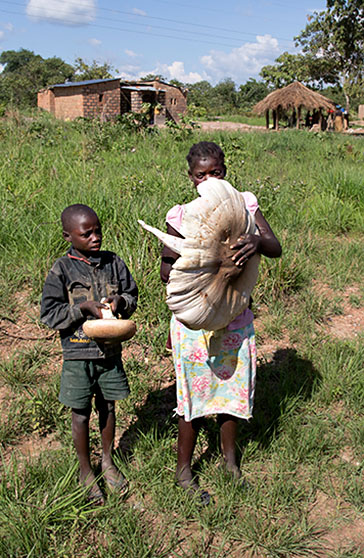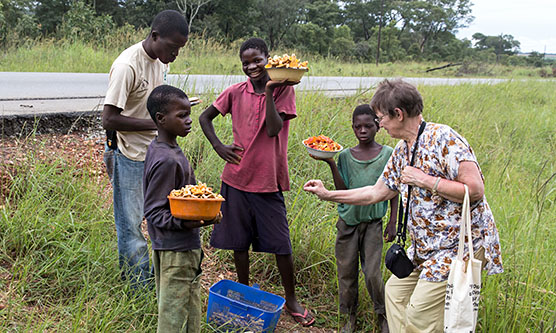Press release 2016-06-14 at 8:47
Mycologists Marja Härkönen, Tuomo Niemelä and Heikki Kotiranta along with their Zambian colleague Keddy Mbindo and British colleague Graham Piearce have published a guidebook on Zambian mushrooms, entitled Zambian mushrooms and mycology. Being the first four-colour illustrated publication on Zambian mushrooms, the book can be considered as a major cultural achievement, as it might be only the second comprehensive handbook on mushrooms native to the African continent. The first, entitled Tanzanian mushrooms, was also primarily written by Härkönen and Niemelä (2003).
In addition to serving as a field guide for mushroom identification, the first part of the book also describes different types of fungi, their biology and growth, their different macro and microscopic structures as well as their various habitats. It is hoped that the book will be of use in the education and training of forestry professionals and that it will also spread to regular schools as well.
The book's extensive species accounts cover over 90 different species, along with their identifying features, edibility and local names in as many tribal languages as the researchers were able to find. According to locals, the best mushrooms in Zambia are a certain species of agaric (Amanita loosei) and various Termitomyces, the largest of which, Termitomyces titanicus, is believed to be the largest mushroom in the world, with a cap that may reach up to one metre in diameter. The book also describes a mushroom species unknown to science up until now, Hexagonia culmicola, which grows on the stems of large grasses.
Collection trips, local heritage and mushroom recipes
Collaboration with the Republic of Zambia on the mushroom book began in 2012, when the researchers reached an agreement to conduct two collection trips in the country. The first research trip, which lasted over three weeks, was conducted in February 2013, towards the end of rainy season. The second collection trip, which also lasted approximately three weeks, was conducted around the start of rainy season, in late November 2013.

The largest Agaricales species in the word,
Termitomyces titanicus, is well-loved in Zambia.
Photo by Heikki Kotiranta.
As people continue to migrate from rural areas into cities, natural heritage is steadily being lost, for instance knowledge on mushrooms, such as their names and edibility. This is why the researchers decided to also record some of the fading heritage on Zambian mushrooms in the book. To do this, researcher Marja Härkönen interviewed rural people from small, far-off villages as well roadside mushroom sellers during the collection trips. The Zambian interviewees were asked the same questions previously used in the Tanzania and Mozambique mushroom projects, which ensured that the results remain comparable.
When fresh mushrooms were not available, interviewees were shown large, colour pictures of the mushrooms. Some of the interviewees, usually the oldest women of the villages, proved to be very knowledgeable about mushrooms, and were able to share a great deal of information on the use, deliciousness (1–3 stars) or toxicity of the mushrooms, as well as their tribal names. The interview questions were first prepared in English, after which Keddy Mbindo translated them into the local language and the answers back into English.
One of the goals of the book project was to also support the food security of the local people. This is why the book also contains simple mushroom-based recipes from around the world, mainly from Africa.
Zambian mushrooms and mycology has already received praise from an international mycological journal, which described the book with adjectives such as splendid, superb and stupendous! (The Global Mycological Journal of International Mycological Association, IMA Fungus, Vol. 6, Issue 2, page 70).
Zambian mushrooms and mycology was produced as part of a collaborative project between the Finnish Environment Institute (SYKE) and the Republic of Zambia. The aim of this project was to develop Zambia's environmental administration as well as the collection, management and utilisation of environmental information. The mushroom collection trips, research and writing of the book were conducted with the help of funds made available through the Institutional Cooperation Instrument (ICI) of the Ministry for Foreign Affairs of Finland. The project was coordinated by the Forestry Department of the Ministry of Lands, Natural Resources and Environmental Protection of Zambia (MLNREP) and the Finnish Environment Institute's Natural Environment Centre together with the Finnish Museum of Natural History (LUOMUS). The publication event of the book was held in the Embassy of Finland in Zambia, Lusaka, on the 4th of November 2015.
More information
Heikki Kotiranta,Finnish Environment Institute, firstname.lastname@ymparisto.fi
tel. +358 295 2513 18
Tuomo Niemelä, Finnish Museum of Natural History, firstname.lastname@helsinki.fi
tel. +358 505 2717 10
Links

Mycologist Marja Härkönen asking roadside mushroom sellers about the prices of their wares.
Photo by Heikki Kotiranta.